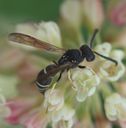Vespoidea
Vespoidea
Classification
- Phylum: Arthropoda
- Subphylum: Hexapoda
- Class: Insecta
- Order: Hymenoptera
- Superfamily: Vespoidea
Pronunciation
How to pronounce Vespoidea: //vɛsˈpɔɪdiə//
These audio files are automatically generated. While they are not always 100% accurate, they are a good starting point.
Images






Summary
Vespoidea is a diverse superfamily of wasps characterized by a range of habits and ecological roles, with significant variations in their morphology and lifestyle. Ongoing research continues to reshape the understanding of their evolutionary relationships.
Physical Characteristics
Vespoid wasp females have antennae with 10 flagellomeres, while males have 11 flagellomeres. The edge of the pronotum reaches or passes the tegula. Many species display some level of sexual dimorphism. Most species have fully developed wings, but some have reduced or absent wings in one or both sexes. Only females are capable of stinging.
Identification Tips
Look for the number of flagellomeres and stinging capability (females only). Presence of sexual dimorphism and wing structure can also aid in identification.
Habitat
Diverse habitats depending on lifestyle: includes environments suitable for eusocial, social, and solitary wasps, as well as habitats for predators, scavengers, parasitoids, and some herbivores.
Distribution
Global distribution with varying presence across regions, depending on family and ecological niche.
Diet
Diet includes a diverse range of food sources; many are predators, scavengers, and parasitoids, while some may have herbivorous habits.
Life Cycle
Life cycles can vary widely among species, including complete metamorphosis with egg, larval, pupal, and adult stages.
Reproduction
Reproductive strategies vary; many species exhibit eusocial behavior, while others are solitary.
Predators
Predators of Vespoidea include larger insects such as birds, mammals, and other predatory insects.
Conservation Status
Conservation status varies by species; some may be threatened due to habitat loss and ecological changes.
Ecosystem Role
Vespoidea play important roles in ecosystems as pollinators, predators of other insects, and scavengers.
Economic Impact
Some species are beneficial as pollinators, while others can be pests due to their stinging behavior, which may lead to negative human interactions.
Cultural Significance
Vespoidea have cultural significance in various societies, especially in relation to their roles in folklore and ecosystems.
Health Concerns
Potential health concerns related to stings from wasps, particularly in allergic individuals.
Collecting Methods
- Netting
- Bait trapping
- Sweep netting
Preservation Methods
- Ethanol preservation
- Pinning
- Drying
Evolution
Evolutionary relationships within Vespoidea are complex and have been revised based on molecular data; paraphyly of the superfamily has been suggested, leading to classifications into smaller families.
Similar Taxa
- Aculeata
- Apoidea
- Formicoidea
- Tiphioidea
Misconceptions
Common misconceptions include the generalization of all wasps as aggressive; behavior varies widely among species.
Tags
- Vespoidea
- Wasps
- Hymenoptera
- Ecosystem
- Diversity
- Taxonomy